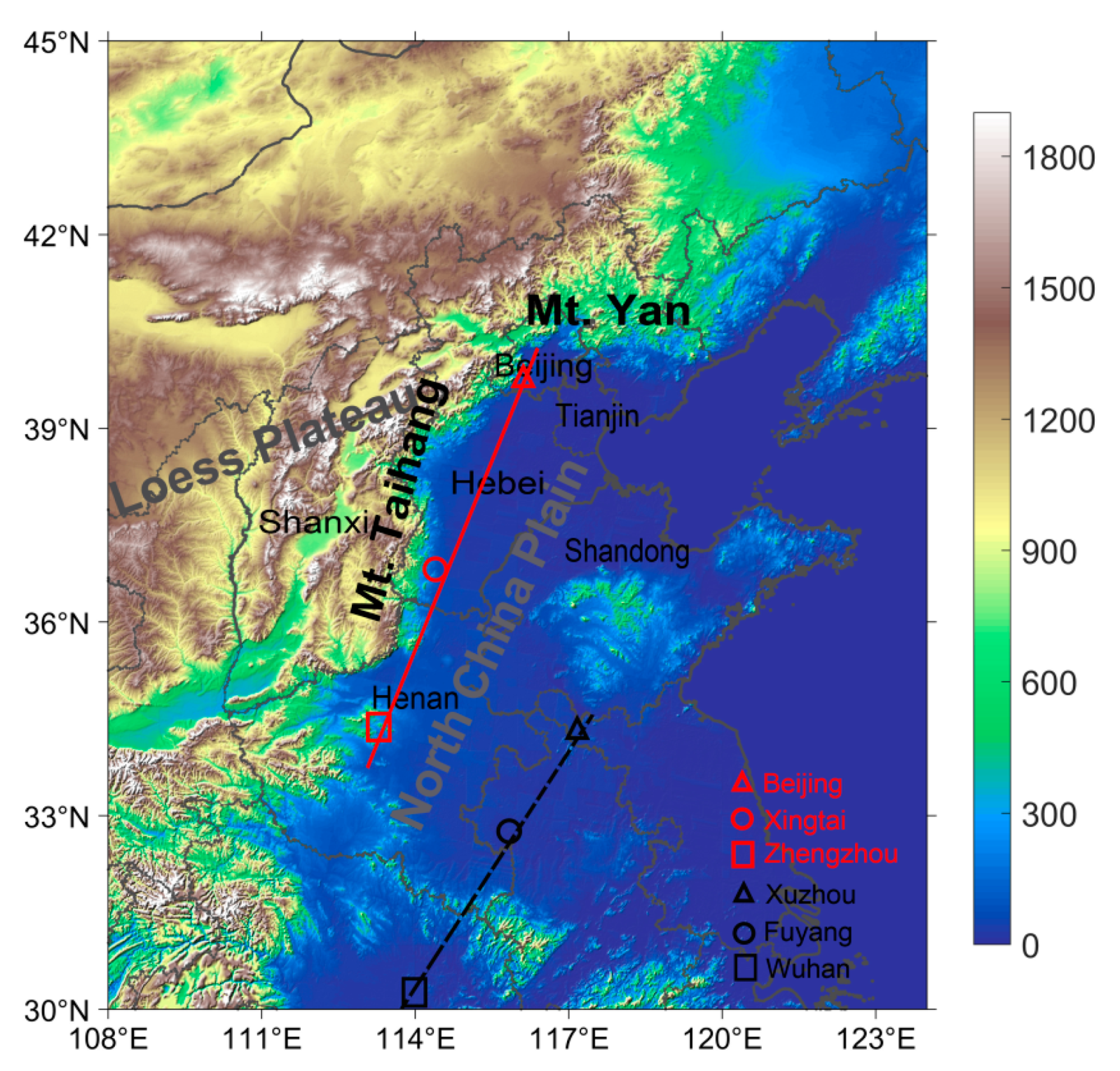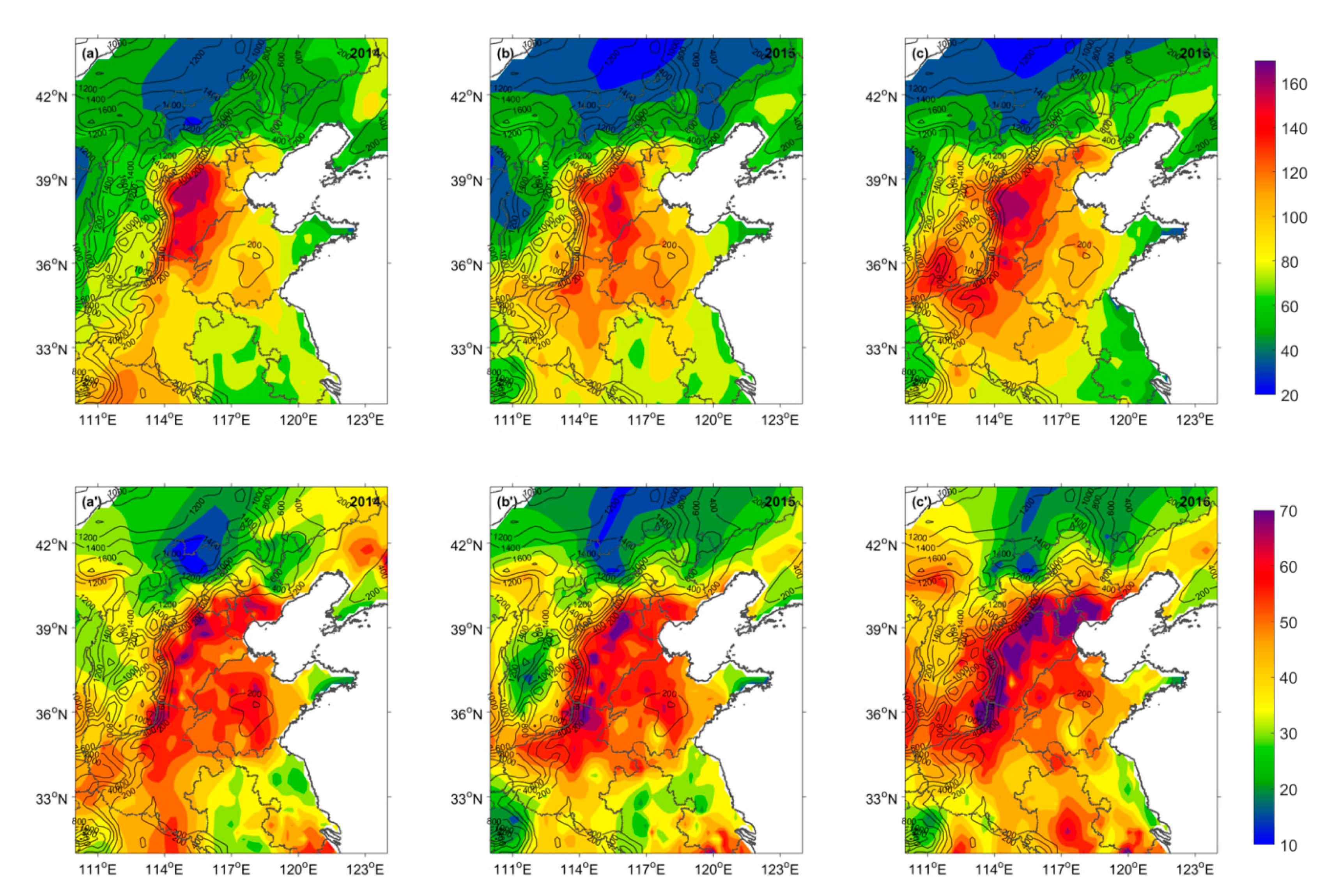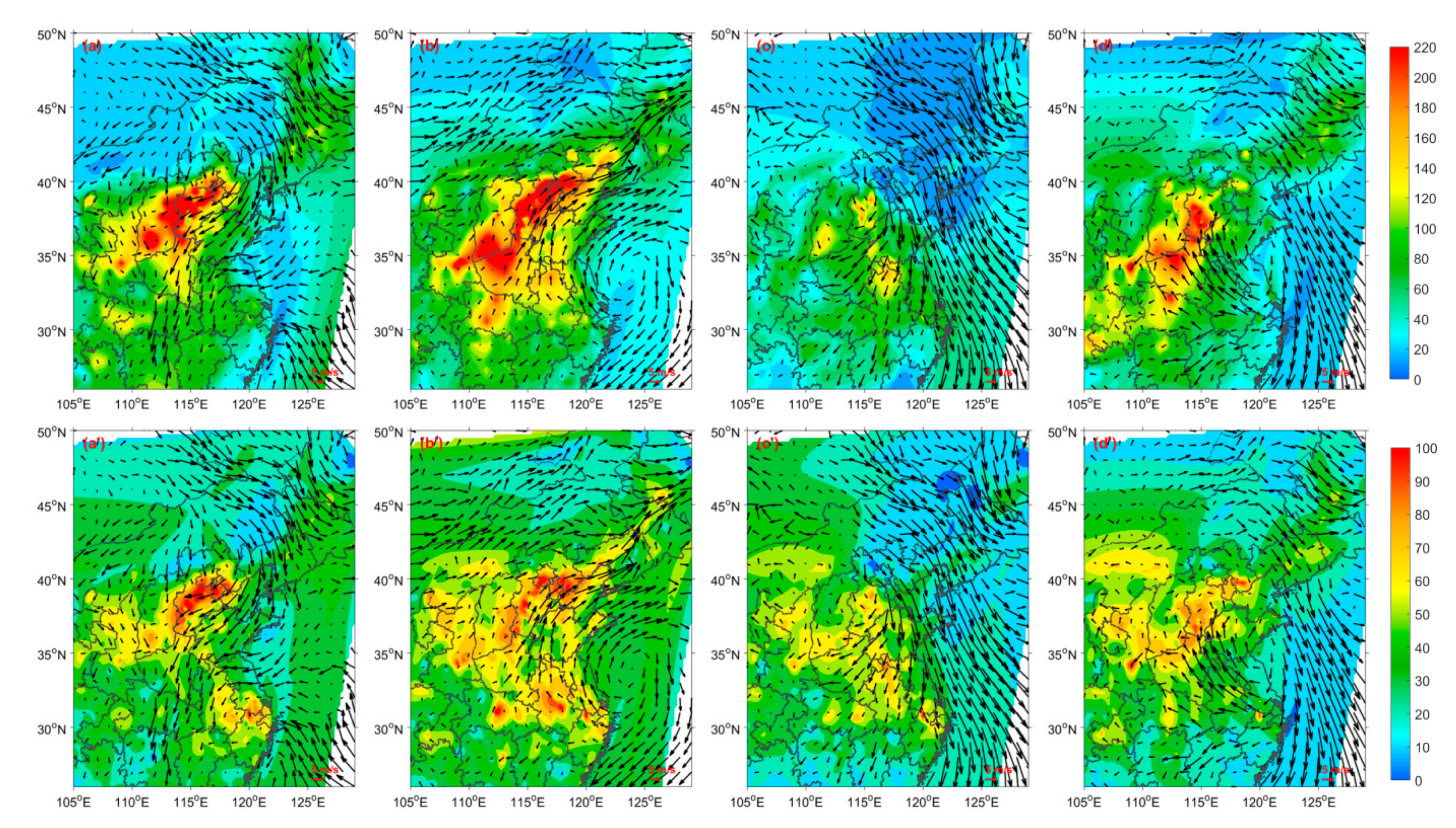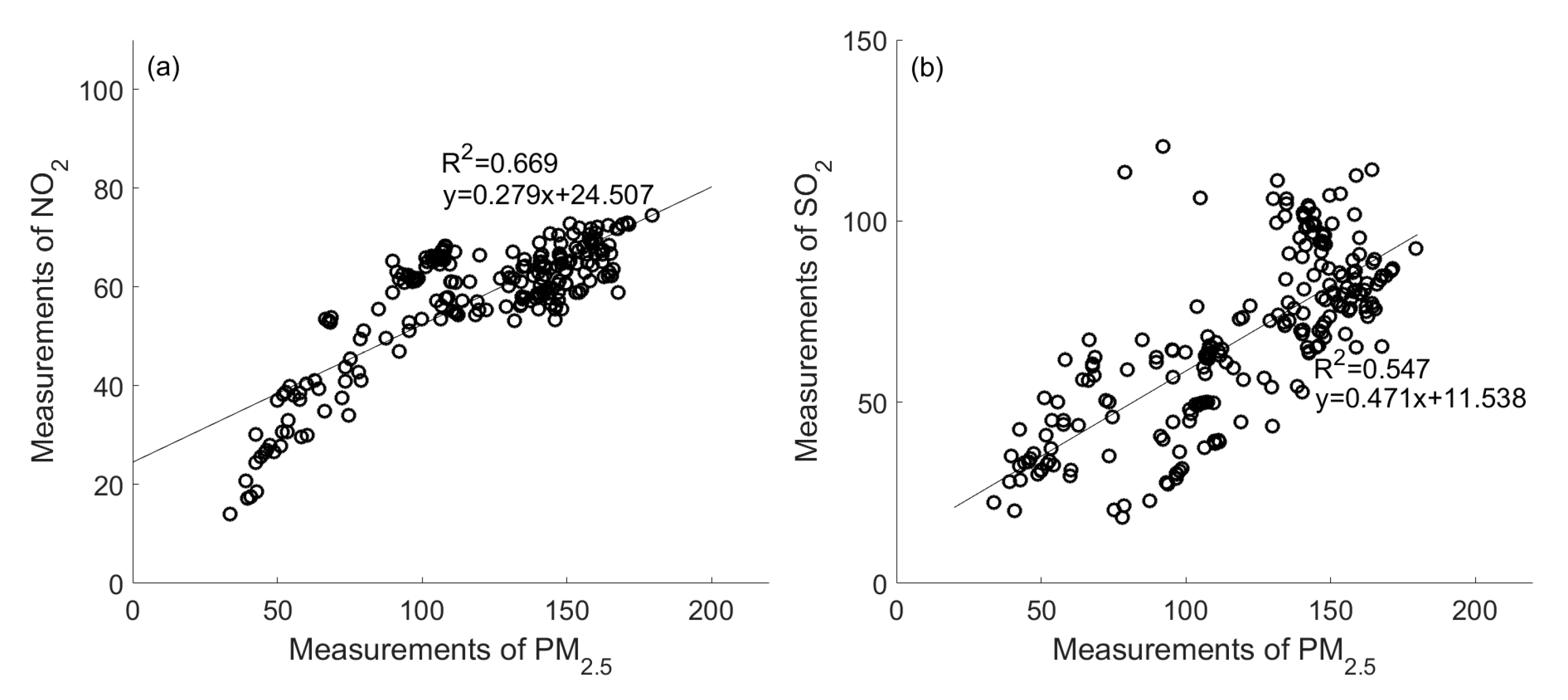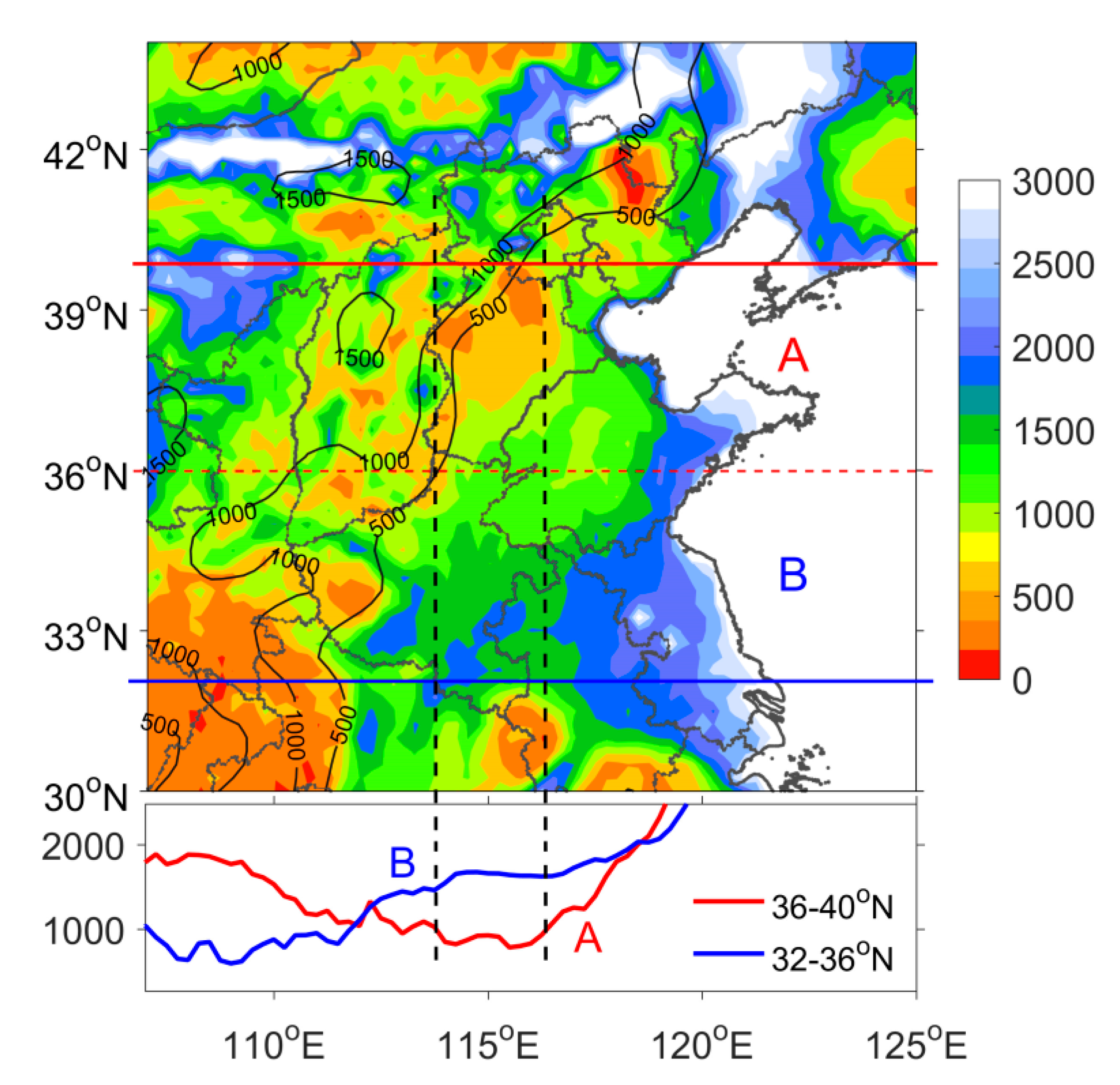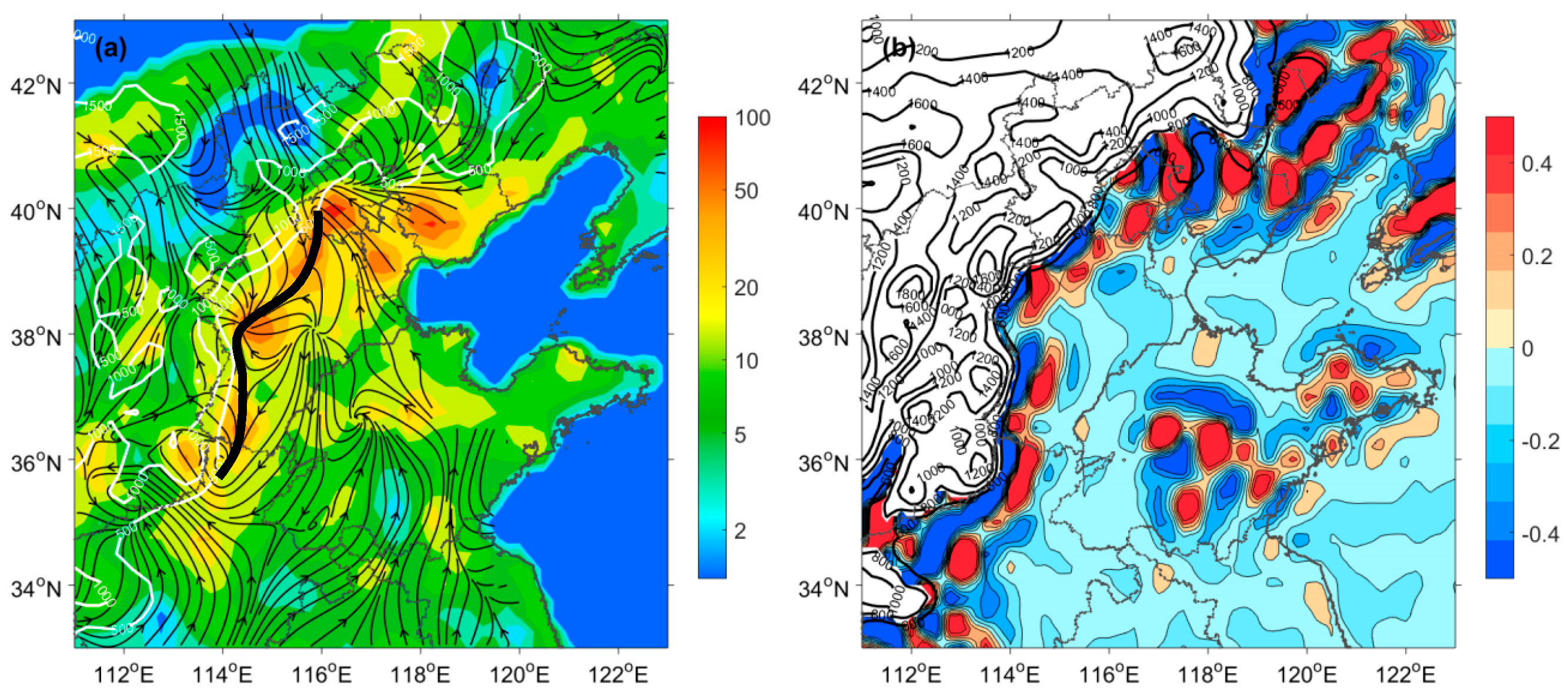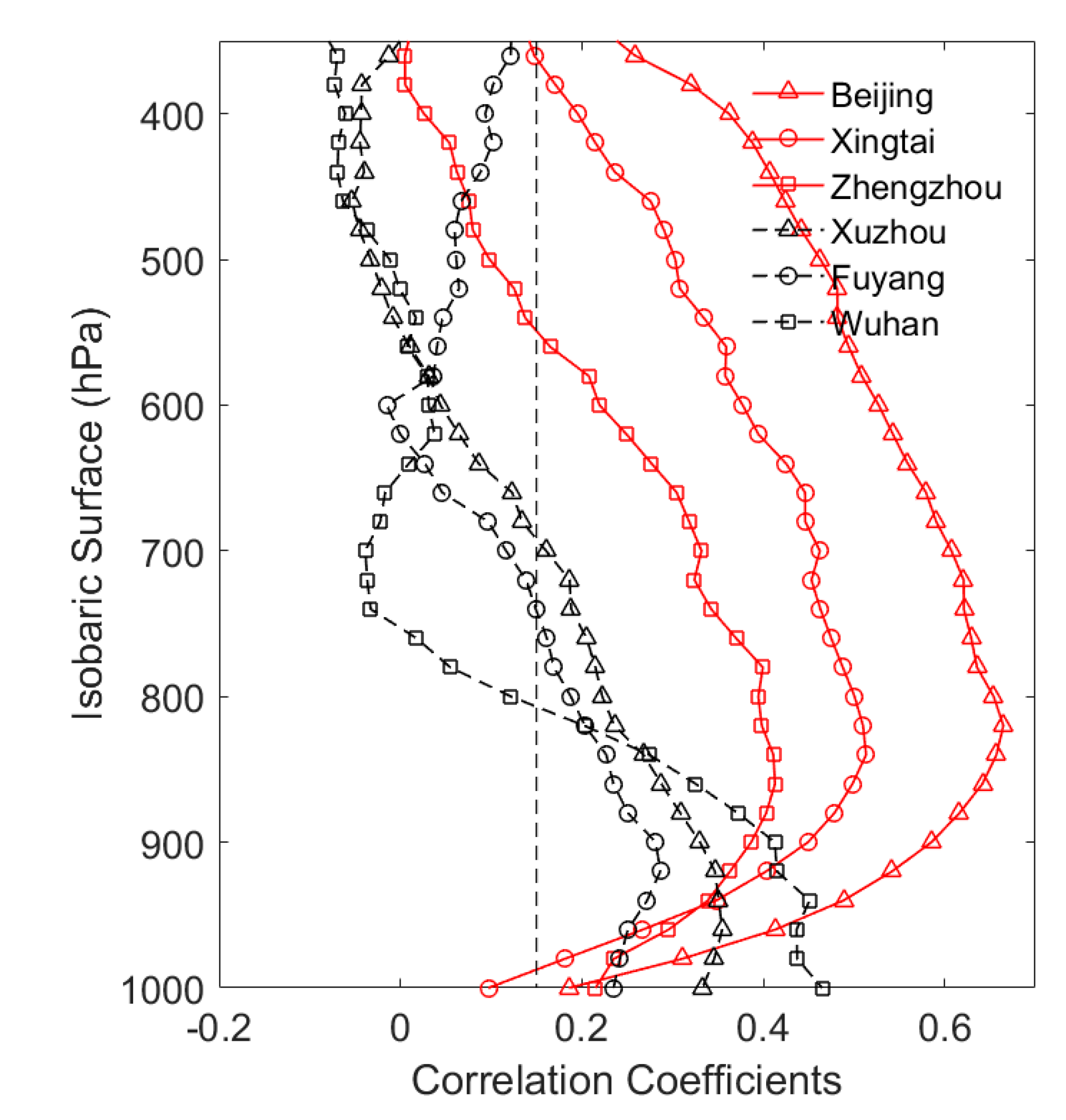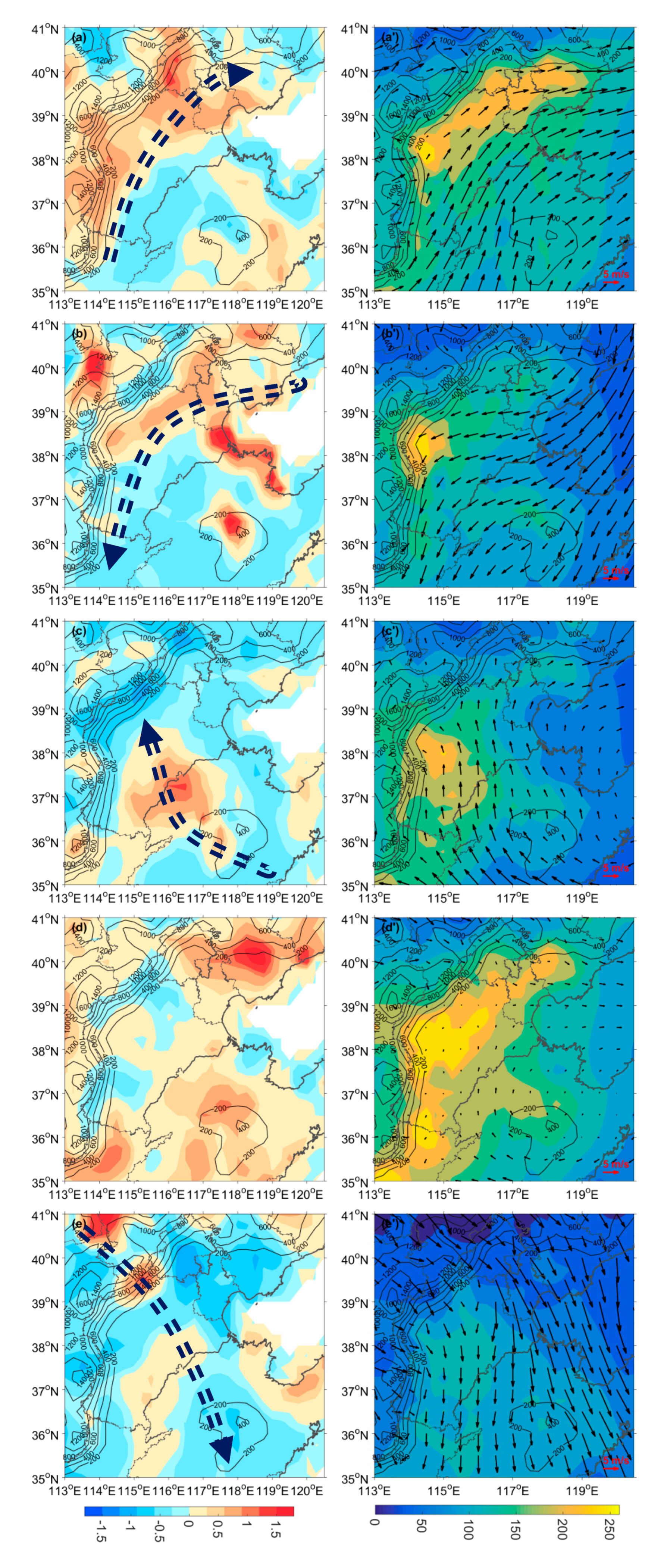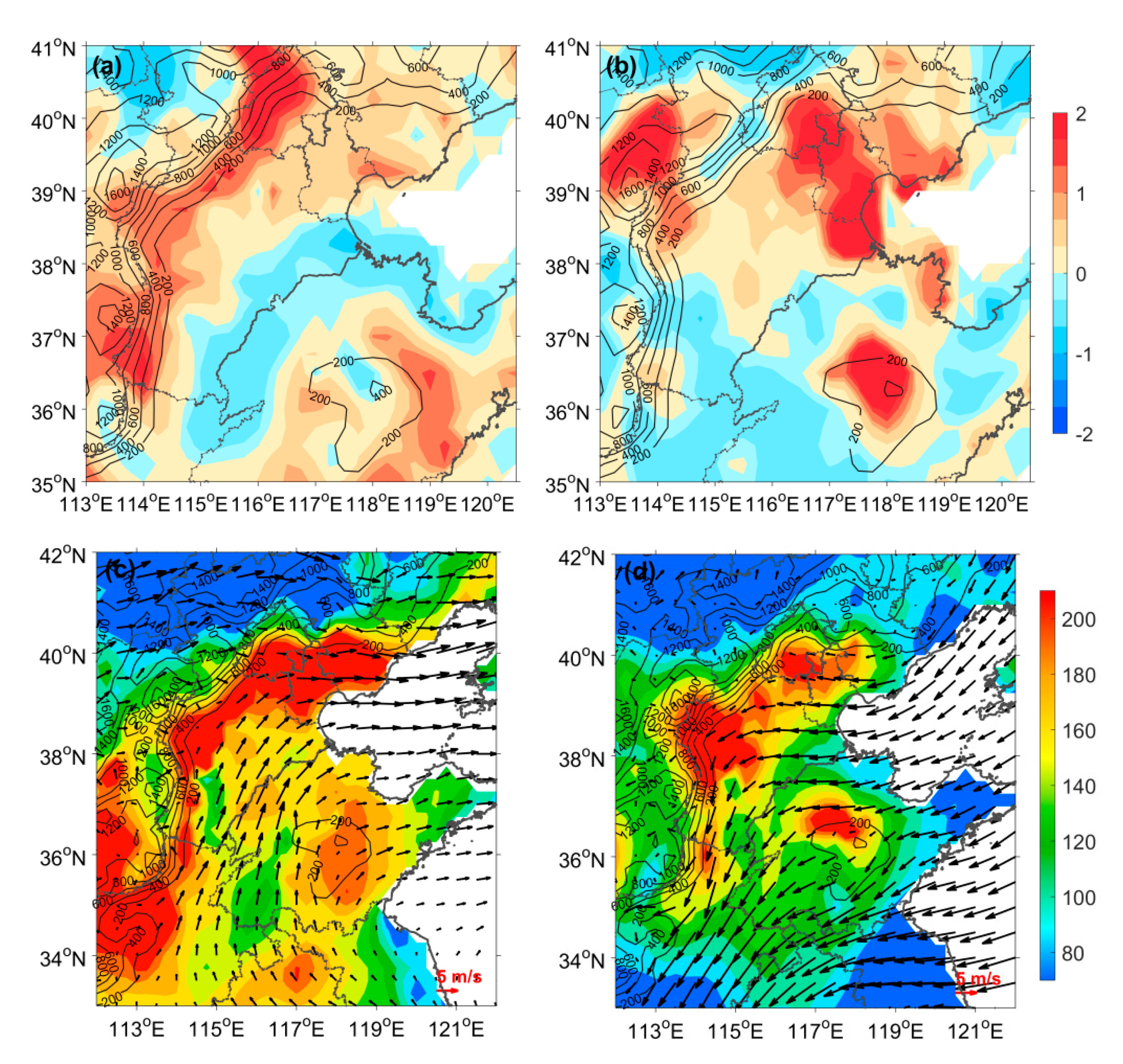1. Introduction
The Beijing-Tianjin-Hebei (BTH) region has been suffering from the most severe haze in China [
1,
2,
3]. Air pollution is closely related to the population density, industrial development, and the traffic intensity. Particulate matter, such as PM
2.5, is the major pollutant of winter haze in the BTH region [
4], and it has a negative impact on ambient air quality and human health [
5,
6,
7]. In 2013, the Chinese government established the “Action Plan for Air Pollution Prevention and Control”. Since the implementation of this measure, pollution control has been moderately successful [
8]. The monitoring results of the ozone monitoring instrument (OMI) indicated that the amount of NO
X emissions in many cities in China has decreased by an average of 21% between 2005 and 2015 [
9]. From 2012 to 2015, SO
2 in the North China Plain was reduced by 50% [
10]. Although the total discharge of pollutants has decreased year by year, haze pollution events still occur occasionally [
11,
12]. In December 2016, five consecutive haze events occurred in the BTH region, with the most severe event occurring between 29 December 2016 and 7 January 2017. This haze event was of a long duration (10 days) and had a wide-ranging impact, accompanied by an explosive growth of PM
2.5 concentrations. The maximum hourly PM
2.5 concentration in Beijing exceeded 500 μg·m
−3 [
13]. Although the intensity of pollution control in the BTH region is unprecedented, the air quality of Baoding, Shijiazhuang, Xingtai, and Handan in the region have still ranked among the last five in China in 2016 and 2017 (Chinese Environmental Status Bulletin), which indicates that weather systems and meteorological factors also play a crucial role in the temporal and spatial evolution of haze pollution, in addition to the pollutant emissions.
Different haze pollution characteristics can be observed under different meteorological conditions and in different regions. Moreover, some regions are more susceptible to haze pollution under certain special meteorological conditions [
14]. Atmospheric circulation, temperature stratification, boundary layer evolution, and air humidity can have a critical effect on the formation of pollution [
15,
16,
17,
18]. When cold air advection is weak, and there are subsidence and stable atmospheric stratification, a stagnant zone can be generated in the lower atmosphere, in which air pollutants are likely to accumulate [
19]. Wu et al. [
20] found that the concentration of SO
2 and NO
2 along the Taihang Mountain region is influenced by the southerly pollution transport, which was 1–2 times higher than that in the northerly wind. Zhang et al. [
21] proposed that the contribution of meteorological factors to the variance of the daily fog and haze evolution reaches 0.68. Local circulation affected by terrain plays an important role under the force of weak large-scale meteorological conditions [
22]. The terrain of the BTH region is complex, with the surrounding mountains (Yan Mountains to the north, Taihang Mountain to the west) and the coast to the east. The elevation differences between the mountainous regions and the plain in the BTH region can be as much as 1000 m (
Figure 1). The mountains block the transport of contaminants and alter the local circulation patterns, resulting in thermal and dynamic structures that are not conducive to pollutant diffusion [
13,
23,
24,
25,
26]. Through observations of the vertical temperature in the Gore River Valley of Colorado, Whiteman and Mckee [
27] found that the inversion in the valley at night fell into the valley after sunrise, which is a common feature in the mountain regions. Guniya et al. [
28] found that foehn processes substantially increase the air pollution level in the mountain countries. Xu et al. [
29] found that there is an obvious wind convergence line downstream of the eastern margin of the Loess Plateau (hereafter referred to as the EMLP) when heavily polluted weather events occur in the BTH region. However, previous studies on haze pollution in the BTH region have focused on the statistical characteristics of pollution distribution and the weather conditions of haze events. We define the “vulnerable region” of air pollution as the highly concentrated band-shaped areas along the EMLP, which are caused by the combination of topography and meteorology, in addition to sources of pollutant emission and distribution of population. The impacts of different weather systems on the effects of emission sources, the synergistic effects of winter-dominated winds and large plateaus, the origin of the north–south pollution belt transport channel, and the causes of unique pollution regions (e.g., “vulnerable regions” to air pollution) are still not well understood. If the synergistic effect of the plateau terrain and the weather system on the spatial distribution of haze is recognized, the causes of the “vulnerable region” to pollution and its meteorological impact can be determined. As a result, urban planners can appropriately adjust the industrial layout and enact city development plans.
This study applied the adaptive emission constraint technique with the nudging method, which is based on the iterative solution to the meteorological–chemical transport model, to constrain daily emissions by considering the impacts of meteorological conditions [
30] (the emissions with the consideration of meteorological conditions will be referred as EMC hereafter) from 1 December 2016 to 31 January 2017. The constraint method uses the Community Multiscale Air Quality (CMAQ) model [
31,
32] as an iterative inversion kernel. In the pollutant concentration prediction equation, the “relaxation adjustment term” of the emission source is included to reduce the error between the simulation result and the observation. Because this method excludes the long-distance transportation of pollutants, it effectively reflects the combined effects of regional meteorological conditions and emissions. By analyzing the correlations between EMC and the daily meteorological factors, as well as the thermal and dynamic parameters, we examined the impacts of different dominant wind fields on the distribution of pollution and the mechanism of the centralization of pollutants along the EMLP. The purpose of this study is to clarify the topographic–meteorological causes of the vulnerability in the BTH region under the influences of the LP and mountain topography.
3. Results and Discussion
We analyzed the special distribution characteristics of pollutant concentration and atmospheric diffusion conditions in the BTH region in winter, and the vertical diffusion difference caused by the influence of plateau. The adaptive nudging constraint method was employed innovatively to quantitatively evaluate the impact of large-scale terrain on the vulnerability to pollution in the BTH region in winter. In
Section 3.1, we analyzed the distribution characteristics of air pollution in the BTH region in winter, using PM
2.5 and NO
2 ground observations and analyzed the spatial distribution of the atmospheric diffusion conditions using, atmospheric ventilation calculated based on wind fields reanalysis data (see
Section 3.2). We used the EMC from 1 December 2016 to 31 January 2017 constrained by the adaptive “nudging” emission constraint method, to quantitatively analyze the physical causes of the vulnerability to pollution in the BTH region under the influence of plateau terrain in winter (see
Section 3.3 and
Section 3.5). In
Section 3.5, PM
2.5 concentrations observations and the 975 hPa mean wind fields reanalysis data were used to analyze the distribution characteristics of low-level wind fields and PM
2.5 concentrations under the influence of typical weather conditions. The influence of plateau on the vertical diffusion of pollutants (see
Section 3.4) was analyzed by using the L-band sounding temperature and NO
2 ground concentration observation data.
3.1. Distribution Characteristics of Pollutants in the BTH Region in Winter
The data from about 1400 atmospheric component ground observation stations in Central and Eastern China (about 220 of them are in the BTH region) were linearly interpolated to 0.25° × 0.25° latitude and longitude grid space. In order to focus on the scope of this study,
Figure 3 only shows the spatial distribution of PM
2.5 and NO
2 concentration ground observations in North China in 2014, 2015, and 2016. From the mean concentration of pollutants in the BTH region in winter, it can be found that the spatial distributions of PM
2.5 in 2014, 2015, and 2016 were generally similar (
Figure 3a–c), and the pollution level was high in the North China Plain, which is surrounded by plateaus and mountains. The average concentration in the region exceeded 100 μg·m
−3. The highest concentration was located in the south-central part of the BTH region and the northern part of Henan, with a maximum concentration of 200 μg·m
−3 or greater, which resulted in a northeast–southwest high-pollution zone along the topography of the EMLP (or Taihang Mountain). However, the concentration of PM
2.5 in the LP west of Taihang Mountain decreased significantly. The distribution of NO
2 was similar to that of PM
2.5 along the topography (
Figure 3a’–c’).
The distribution of wind fields and pollutants on four selected days (
Figure 4) indicates that the daily distribution of pollutants has changed dramatically and both the intensity and impact scope of pollution changed significantly, indicating that the daily evolution of the weather system or the wind field determines the distribution and changes of the state of pollution under a certain background of emissions. Obviously, pollutants are driven by the wind, and the regions with the highest concentrations of pollution are at the front of the dominant wind. Such results indicate that different weather systems or wind fields have different effects on the distribution and accumulation of pollutants. The spatiotemporal distribution of pollutants (
Figure 4) also shows that there is a synchronous change between NO
2 and PM
2.5. The correlation coefficients among PM
2.5, NO
2, and SO
2 in the BTH region in the winter of 2014, 2015, and 2016 were calculated (
Figure 5a,b), with the spatial correlation coefficient between PM
2.5 and NO
2 reaching 0.82, and that between SO
2 and PM
2.5 reaching 0.74. The above correlation coefficients all passed the 99% significance test.
PM
2.5 is the primary pollutant in the BTH region during winter, and its correlation with NO
2 is higher than that with SO
2. The results presented in
Section 2.2.3 show that the EMC of NO
2 had a higher reliability. In this study, we used NO
2 observations and EMC to analyze the causes of the spatial distribution of pollutants accumulated in the piedmont under the combined influence of the plateau topography and meteorological conditions.
3.2. Weak Wind Zone Background
In winter, the leeward slope of the LP experiences a significant downdraft influenced by the topography of the plateau, resulting in weaker near-surface winds [
13,
14]. According to the distribution of average winter ventilation in 2016 (
Figure 6), the distribution of ventilation across North China Plain was uneven. The highest ventilation was in the East China Sea, and the atmospheric diffusion conditions in the LP and the East China Plain were relatively good. In the topographic highs and lows of the central and southern parts of the BTH region, the atmospheric diffusion conditions were relatively poor. From the 36° to 40° N zonal average ventilation curve (the lower panel in
Figure 6), it can be seen that the region from 114° to 117° E corresponded to the topographic transition from the plateau to the plain, which is a valley of atmospheric ventilation. Weak background wind field is not conducive to the diffusion of pollutants, and there is a substantial accumulation of pollutants in the weak wind zone on the EMLP. As a comparison, the atmospheric diffusion conditions in Henan and Shandong in the southern region (32°–36° N) were better.
3.3. Convergence Zone of Pollution on the EMLP
The results presented in
Section 2.2.3 show that the EMC of NO
2 had high reliability. The results presented in
Section 3.1 show that the correlation coefficient between PM
2.5 and NO
2 is very high in recent years. We used NO
2 observations and model-constraint EMC to analyze the causes of the spatial distribution of pollutants accumulated in the piedmont under the combined influence of the plateau topography and meteorological conditions.
Figure 7a shows the correlation coefficient vector calculated by using the EMC of NO
2 and the 975 hPa wind field data from 1 December 2016 to 31 January 2017. Correlation coefficient vector is the point-to-point correlation coefficient between EMC and 975 hPa wind field, which gives the correlation coefficient vector field in the x and y directions. The figure shows that there is a northeast–southwest convergent line along Beijing, to Central and Southern Hebei and the north of Henan, which indicates that the pollutants emitted into the atmosphere converge in this zone. By comparing the topographic distribution of such zones, it is found that the convergence line is near the EMLP (or Taihang Mountain), indicating that the convergence line is probably related to the interaction between the leeward airflows and the wind field in the eastern plain. Under the combined effects of plateau topography and circulation, a pollution zone tends to form on the EMLP.
We calculated the vertical vorticity using NCEP 975 hPa wind data from 1 December 2016 to 31 January 2017 and processed the vorticity field by using the filtering method, and then subtracted the filtered vorticity from the calculated original vorticity. The sub-synoptic scale vorticity field is then obtained, as shown in
Figure 7b. It can be seen that there is a significant north–south chained vortex sequence on the EMLP (
Figure 7b), which is generated by the vortex effect of the airflow over the leeward slope of the Loess Plateau [
24]. The vorticity chains correspond to the correlation vector convergence and the accumulation of pollutant in
Figure 7a. Combined with the WINEMIS of NO
2 (
Figure 7a), the convergence line overlaps the high emission zone in the BTH region. For high emissions, the combination of topography and horizontal wind fields promote the formation of typical pollution transport pathways in the North China Plain in the EMLP, during the winter.
The correlation coefficient vector from Tianjin to Beijing exhibits a consistent south-easterly wind, indicating that Beijing is affected by the emissions from upstream of Tianjin, and such wind transports pollutants downstream. When the pollutant stream encounters the mountainous regions to the northwest, the pollutants will accumulate there.
3.4. The Influence of Plateau on the Vertical Diffusion of Pollutants
In this section, we cover representative stations both near to (Beijing, Xingtai, and Zhengzhou) and far from (Xuzhou, Fuyang, and Wuhan) the plateau (
Figure 1), to investigate the effects of the plateau on the vertical diffusion of pollutants. Zhu et al. [
13] calculated the vertical correlation coefficient profiles between the PM
2.5 concentration and air temperature by using the L-band sounding data and the daily averaged PM
2.5 concentration data from January 2016 to January 2017 in Beijing. In this study, we analyzed the differences in atmospheric thermal structures at different distances from the plateau and the vertical diffusion of pollutants by calculating the correlation coefficient profiles between the observed concentration of NO
2 and the L-band sounding temperature for the winters of 2014, 2015, and 2016 (
Figure 8). The correlation coefficients of all sites below 800 hPa passed the 99% confidence test. The correlation coefficient profiles show that the three stations near the plateau exhibit a strong inversion profile, which is similar to the inversion layer of temperature sounding. The near-surface temperature is low, and the upper temperature increases rapidly, forming a stable atmospheric stratification, which inhibits the vertical diffusion of pollutants and causes pollutants to accumulate in a narrow space near the ground. The correlation coefficient profiles of the Xuzhou and Fuyang stations, which are both located far away from the plateau, have similar inverse thermal structures, but the horizontal span of the inversion temperature is very small, i.e., the inversion intensity is weak. Meanwhile, the correlation coefficient profile of the Wuhan station does not exhibit an obvious inversion structure. Additionally, the inversion layers of the stations near the plateau are deep and extend upward to 850 hPa, whereas the inversion layers of the stations far away from the plateau are below 900 hPa. Such difference in thermal structures at different distances from the plateau might be related to the regional circulation under the influence of the plateau and large-scale topography. The above analysis shows that a “warm cover” is often formed in the air above the plateau, and under its influence, there is a strong inhibitory effect that hinders the vertical diffusion of pollutants.
3.5. Differences in the Influence of Emissions under Different Weather Conditions
In this section, we will discuss the typical weather conditions affecting air quality in the BTH region during the period from 1 December 2016 to 31 January 2017. South-westerly winds, north-easterly winds, south-easterly winds, stagnant air, and north-westerly winds are the five typical wind conditions in the BTH region, and they were used to analyze the effects of different weather conditions or wind fields on pollution conditions. The selected weather processes maintain consistent wind field characteristics within the BTH region. In the two-month period, the number of days of south-westerly winds, stagnant air, north-easterly winds, south-easterly winds, and north-westerly winds were 14, 11, 8, 6, and 8, respectively. We first compare the EMC of each day with the two-month average of EMC (WINEMIS), i.e., (EMC-WINEMIS)/WINEMIS. We then classify the daily (EMC-WINEMIS)/WINEMIS results based on the corresponding wind field conditions. Therefore, the spatial distribution of the vulnerability of air pollution under different wind field conditions can be quantitatively analyzed.
Figure 9a–e shows the relative deviations between the average EMC under different weather conditions and the WIN-EMIS. From this deviation, we can recognize and quantify the significant spatial differences in the effects of emission sources under different meteorological conditions in the BTH region. As shown in
Figure 9a, under the influence of a south-westerly wind, the significant pollutants’ accumulation area is located near the eastern foothills of the Taihang Mountains and the southern slopes of the Yan Mountains. The south-westerly wind amplifies the effects of emissions by an average of 50% to 150% in the region, which results in the intensification of pollution and deterioration of the air quality in the regions along the mountains. Under the north-easterly prevailing winds (
Figure 9b), the emission effect is increased significantly at the southern slope of Yanshan Mountain and the northeast side of Taihang Mountain. Under the south-easterly prevailing winds (
Figure 9c), the effects of emissions on the Southeastern BTH region increase. Under the stagnant air (
Figure 9d), the scope of high-impact pollution increases, and most of the effects of emissions on the BTH region increase. These four typical weather patterns cause various air pollution patterns and different emission effects. However, the most influential regions are primarily concentrated within 200 km of the east side of the plateau. Among these weather patterns, the south-westerly prevailing wind and the stagnant air conditions are most common in the BTH region during the winter. Such weather patterns have a significant multiplier effect on pollution emissions in the region, thereby maximizing regional pollution emissions.
The distribution characteristic of PM
2.5 showed differences under the influence of the four different types of prevailing wind systems.
Figure 9a’ shows that, under the influence of south-westerly winds, the high PM
2.5 concentration area was concentrated in the Piedmont region, which was consistent with the emission pattern presented in
Figure 9a, which highlighted the impact of the emission effect. The average concentration of PM
2.5 in front of the mountain was 200 μg·m
−3 or greater. Under the influence of north-easterly prevailing winds (
Figure 9b’), the high PM
2.5 concentration was concentrated in the region east of the Taihang Mountains. Under the south-easterly prevailing winds (
Figure 9c’), the highest concentration of PM
2.5 was still concentrated in the piedmont of the Taihang Mountain due to the northwest direction of atmospheric transport. Under the stagnant air conditions (
Figure 9d’), the concentrations of PM
2.5 in the plain regions were generally high, with an average of over 200 μg·m
−3. From the analyses of the above emission effects and the distributions of PM
2.5, we concluded that large amounts of pollutants are often concentrated along the EMLP in the BTH region during winter. Therefore, the EMLP has become the most heavily polluted region, which is consistent with the distribution of winter pollutants presented in
Section 3.1.
Because of strong winds and low emissions upstream, the north-westerly wind typically has a pollution-removal effect in the BTH region, and the intensity of the EMC is significantly lower than that of the WINEMIS (
Figure 9e,e’). The north-westerly wind has the most significant impact on Beijing, Tianjin, and the eastern border of the Taihang Mountains, where PM
2.5 concentrations have declined significantly.
3.6. Comprehensive Causes of “Vulnerable Regions” of Pollution in the BTH Region
The terrain of the BTH region is complex. The northern Yan Mountains and the western LP (or Mt. Taihang) form a boundary that partially encloses the region, and there is a large area of open terrain to the south. A weak wind zone is created on the EMLP due to the influence of the plateau and mountains on the regional atmospheric circulation. Additionally, a north–south sub-synoptic scale vortex circulation sequence is formed on the EMLP, and the corresponding wind field convergence between the positive and negative vorticity sequences form a significant convergence zone of pollutants (
Figure 7). The “warm-cover” formed by a temperature anomaly over the EMLP inhibits the vertical diffusion of pollutants. These mechanisms force pollutants to converge in a strip on the EMLP. When south-westerly and north-easterly winds prevail, the pollution belts move longitudinally to the north and south along the boundary of the EMLP under the impetus of the wind fields. In this situation, pollution persists in the EMLP. The north–south “vortex sequence” formed along the EMLP terrain is similar to the “train effect” of pollution (
Figure 7b). Therefore, south-westerly and north-easterly winds are more conducive to maintaining a prolonged haze event in addition to the regional transport of pollutants. The south-westerly wind causes pollutants to accumulate to the south of the Yan Mountains, which intensifies the haze in Beijing and Tianjin. Under the influence of the above-mentioned atmospheric dynamical and thermal processes, the EMLP has become a “vulnerable region” to haze pollution because its meteorological condition is unfavorable to the spread and diffusion of pollutants, which means that the region is more vulnerable to air pollution even in the same emission background. The above mechanisms also explain the centralization of pollutants along the plateau noted in
Section 3.1. In recent years, although the governments of Beijing, Tianjin, and Hebei have increased the efforts to control air pollution, the intensity of pollution emissions is still high. This fact, combined with the vulnerability to air pollution and the frequent adverse weather conditions, has made the region the most polluted area in China.
4. The Cross-Year Haze Event of 2016–2017
There was a long period of heavy haze in the BTH region from 29 December 2016 to 7 January 2017. During this pollution period, high concentrations of pollutants were primarily concentrated in the BTH, Shandong, northern Henan, and Guanzhong. The air quality in these regions reached heavy (MEPC, HJ6333-2012) or severe pollution levels. The haze pollution was obviously heavier in the BTH region than that in other regions. On 1 January and 4 January 2017, the PM2.5 concentrations in Beijing reached two peaks, both exceeding 500 μg·m−3.
In the first six days of the haze event (29 December 2016 to 3 January 2017), the high-pressure system was located on the eastern coast of China, and the south-westerly wind dominated the lower atmosphere of the BTH region (
Figure 10a,c). According to the analyses in
Section 3.5, the emission effect at the EMLP was enhanced, and the pollutants converged into strips and moved longitudinally under the influence of the south-westerly wind. The “train effect” caused pollutants to be blocked, which made them accumulate at the Yan Mountains and the cities along the Taihang Mountains. Beijing, Tianjin, and Tangshan experienced persistent haze. At the later stage of the haze event (4 January to 7 January 2017) (
Figure 10b,d), cold air moved from northeast to southwest, and the pollutants converged on the EMLP, where the haze persisted. By analyzing this process, we find that pollutants were concentrated in the regions along the mountains under the influence of the plateau and large terrain, which is caused by the unique thermal and dynamic processes. With the alternating dominance of south-westerly and north-easterly winds, the pollutants oscillate in the north–south direction along the mountainous region, which leads to the long-term persistence of haze pollution.
5. Conclusions
Surrounded by the “semi-enclosed” and the southward-opening terrain formed by the LP, a contamination conveyor belt is distributed along the topography of the EMLP in the BTH region. In this study, based on the innovative adaptive nudging constraint method, we quantitatively analyzed the differences in the influence of emission sources under different dynamic and thermal conditions in the BTH region, which is impacted by a special large-scale leeward slope terrain. The mechanism of air pollution vulnerability in the BTH region and the comprehensive effects of terrain–meteorological conditions on air pollution were also discussed.
The weak atmospheric ventilation on the EMLP is not conducive to the diffusion and dilution of pollutants. Additionally, under the influence of topography, a north–south vortex circulation sequence of the sub-synoptic scale is formed. The convergence of the wind fields corresponding to the positive and negative vorticity sequences results in a significant convergence of pollution. The convergence line passed from Beijing to Central and Southern Hebei and to the north part of Henan. The pollutants released into the atmosphere tend to converge in this strip zone. The “warm cover” formed over the upper air of the EMLP hinders the vertical diffusion of pollutants. Due to the influence of plateau topography and regional atmospheric circulation, the EMLP has become a “naturally vulnerable region” to haze pollution, which is unfavorable to pollutant diffusion.
There are significant spatial differences in the effects of emission sources under different meteorological conditions or wind field patterns. We quantitatively analyzed the effects and distribution characteristics of emission sources under different meteorological conditions in the BTH region for a two-month period. Under the predominant south-westerly winds, pollutants tended to accumulate near the eastern foothills of the Taihang Mountains and the south of the Yan Mountains. Under the influence of north-easterly winds, pollutants were concentrated in the south of Yan Mountain and the northeastern side of the Taihang Mountains. Under the predominant south-easterly winds, the southeastern part of the BTH region was the most vulnerable region to pollution. In the case of stagnant air, the impact of emissions in most areas of BTH is significantly enhanced. Such wind fields amplified the effects of emissions by an average of 50% to 150% in the EMLP. When southwest and northeast winds alternated, the pollution belt moved longitudinally along the south–north direction of the EMLP under the impetus of the wind fields. The north–south “vortex sequence” along the EMLP mimicked the “train effect” of pollution, which caused continuous pollution conditions in the EMLP. Although different weather systems have different effects on the distribution and accumulation of pollutants, the regions with the greatest impact on emissions were all located in the Piedmont region, indicating that such regions are more vulnerable to severe air pollution.
